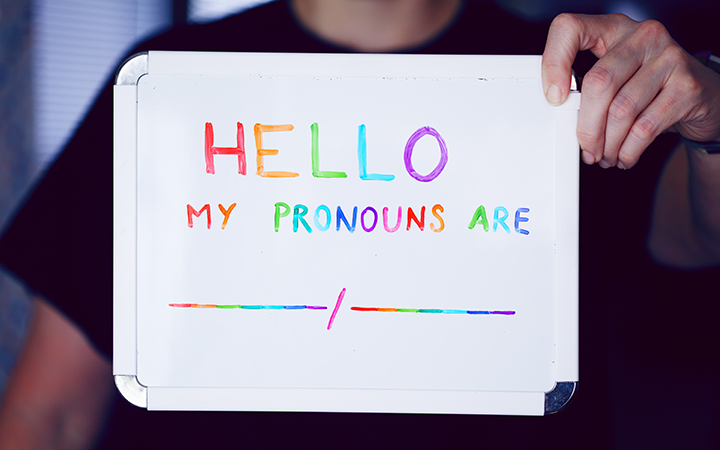Insight
He/She/They: Prioritising Preferred Pronouns

You’ve probably seen the following popping up on social media profiles or email signatures after people’s name: she/her, he/him, they/them, or even they/he or she/they. But what does it mean?
It’s actually not that complicated! Pronouns simply replace a proper noun, or name, in conversation. Instead of saying “That’s Trevor’s coat” you could say “That’s his/her/their coat.”
Pronouns have been deep within the ongoing conversation of gender and gender identity. Before we dive into how to correctly use preferred pronouns, let’s define the differences between sex, sexual orientation, and gender.
Sex refers to a person's biological status and is typically assigned at birth (male, female, intersex).
Gender is often defined as a social construct of norms, behaviors and roles that varies between societies and over time (man, woman, nonbinary).
Sexual orientation refers to physical, romantic and/or emotional attraction to members of the same and/or other genders (straight, gay, bisexual, lesbian, etc.)
See how they’re all different? It’s important to note that no matter what someone was assigned at birth (male/female/intersex), their gender identity exists separately. It’s gender identity that tends to influence pronouns.
Pronouns & Business Travel
Using a person's correct pronouns is a matter of respect, and organisations around the world are listening.
Countries including the Netherlands, Argentina, Australia, Denmark, Ireland, Germany, New Zealand and United States allow passport holders to mark their gender as non-binary or X. However, the issue of these passports does not guarantee entry or transit through other countries, if they do not recognise the X gender marker.
If you know your traveller has an X on their passport, you’ll want to ensure you’re sending them to locations that will honour and affirm their gender identity and not put them at an increased risk. 69 counties still have anti-LGBTQ+ laws in place, with some upholding outright bans.

Gender Identity and Travel Technology
So you know a traveller’s preferred pronouns. How do you add them to your travel tech so you make sure their gender identity is affirmed throughout the travel process? While many HR IT systems have started to include preferred pronouns in their employee profiles, it’s a bit more complicated for travel tech.
How can the corporate travel industry work together to ensure technology can support travellers of all genders? For one thing, "the traveller profile needs to sync with other systems, like the GDS or OBT", says Michel Rouse, Chief Product Officer. "Not all GDS and OBT systems currently support X or U gender markers or non-gendered titles, which could cause a break in the connection between systems." Airlines, hotels, TMCs and other travel organisations all need to collaborate to address the barriers to a seamless travel experience for transgender and non-binary travellers.
The journey of affirming gender identity in travel still has a long way to go, but the first place we can start is with our tech and policies. Talk with your Account Manager and let them know your organisation’s desire for more gender inclusivity, especially adding preferred pronouns. Now that the more and more countries around the world adopt this change, the need to for our tech and procedures to adapt is more important than ever.
Next Steps
There are simple things you can do to start your organisation on the right path to gender equity and inclusions. Encourage employees to include preferred pronouns in their email signatures, virtual meeting profiles, and nametags at in-person events. Switch to HR IT systems that support preferred pronouns and pass out literature that helps employees and business travellers understand the importance of respecting preferred pronouns and gender identity. Together, we’ll make the business travel world an even more inclusive place.